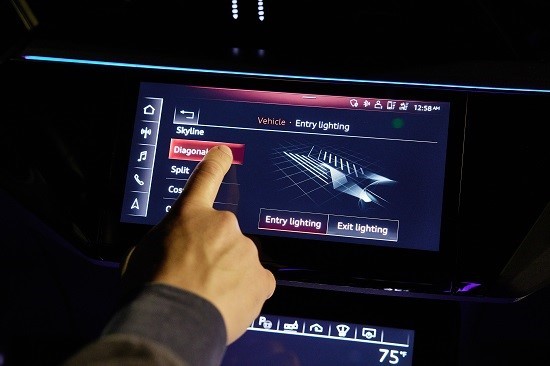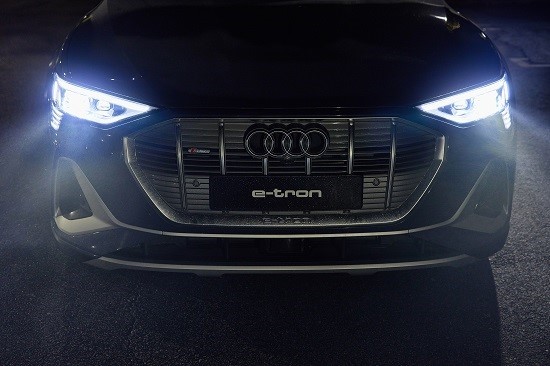I am driving in the California hills high
above Malibu, in a deep-blue electric
Audi E-tron, and I turn onto a
pitch-black winding road. Instinctively, I reach to turn on the high beams. But
before I have a chance to do so, the low beams automatically rise and spread
out like a hand fan, filling the entire roadway with light and projecting it
far into the distance.
اضافة اعلان
A few seconds later, the headlights of an
approaching vehicle set my headlights in motion; the high beams angle down as
the light continually shape-shifts, changing patterns to avoid illuminating the
oncoming car.
I had just experienced adaptive driving beam, or
ADB, headlights, one of the most important advances in vehicle lighting
technology in decades. With ADB lighting, a vehicle’s headlights are
essentially always on high beam, while cameras and software instruct them to
constantly reshape the beam to avoid blinding oncoming drivers or shining in
the rearview mirrors of those close ahead.
 Screen controls for matrix LED “smart” headlights on an Audi E-tron, an electric car, in Los Angeles, December 17, 2021. Adaptive driving beam (ADB) headlights, widely used in Europe and Asia for over a decade, will finally soon be on American cars and trucks, thanks to a section in the recently passed Infrastructure Investment and Jobs Act that mandates their use.
Screen controls for matrix LED “smart” headlights on an Audi E-tron, an electric car, in Los Angeles, December 17, 2021. Adaptive driving beam (ADB) headlights, widely used in Europe and Asia for over a decade, will finally soon be on American cars and trucks, thanks to a section in the recently passed Infrastructure Investment and Jobs Act that mandates their use.
The bad news is that while widely used in
Europe and
Asia for over a decade, these smart headlights are illegal in the US. On my
demonstration drive, I was piloting a not-for-sale-here European model of the
E-tron equipped with Audi’s futuristic digital matrix headlighting system.
The good news is that after years of unsuccessful
attempts to allow the technology, ADB lights will soon be on US cars and
trucks, thanks to a section in the recently passed Infrastructure Investment
and Jobs Act that mandates their use.
According to the infrastructure act, adaptive beam
headlights must be approved for US use within two years. And they will be
allowed to meet the standard developed by the Society of Automotive Engineers,
which is very similar to the systems already in use in Europe.
Lives and dollars are stake. Smart headlights are
expected to pay off with substantial safety gains, according to a 2019 study
from AAA. Widespread adoption would prevent thousands of crashes involving
pedestrians and cyclists annually, the report said.
Using federal data from 2015, the study reported
about 2,000 pedestrian deaths, and 31,000 injuries, in which alcohol was not a
factor but dark or low-light conditions were. It pointed to about 14,000 such
crashes involving cyclists. AAA expects that smart headlights would prevent at
least 6 percent of these crashes, resulting in thousands of saved lives and
over $1 billion in reduced economic and societal expense.
 Projection animation that is part of the starting up and shutting down process for matrix LED “smart” headlights on an Audi E-tron, an electric car, in Los Angeles, December 17, 2021.
Projection animation that is part of the starting up and shutting down process for matrix LED “smart” headlights on an Audi E-tron, an electric car, in Los Angeles, December 17, 2021.
The report also predicted 18,000 fewer crashes
involving wildlife (it noted there were roughly 290,000 a year), saving a
further $500 million a year.
The ADB systems ease nighttime driver strain,
according to research conducted by Valeo, a major vehicle lighting technology
supplier. The company’s study found that driver stress levels, as measured by
heart rate variability, declined by 36 percent when ADB systems were used
instead of standard low beams.
“Once you drive a vehicle with adaptive beams,
you’ll see how great it is,” said Bill Gouse, director of federal program
management for SAE International, a standards-setting organization. “With ADB,
you’ll no longer have to look off at a tree to save your vision because someone
is coming toward you with their high beams on. This is our chance to stop
lagging behind the standards used around the world.”
Zdravko Miric, technical manager for vehicle safety
standards at BMW of America, echoed that sentiment. “We’re really excited to
offer ADB lights in the US market,” he said. “It’s definitely a welcome advance
in lighting technology.”
The number of beam patterns offered by ADB systems
differs, based on each carmaker’s technology. General Motors autos in China
equipped with ADB can create 34 beam patterns, while digital systems from Audi
and Mercedes-Benz use millions of micromirrors to create a virtually infinite
number of shapes.
 Screen controls for matrix LED “smart” headlights on an Audi E-tron, an electric car, in Los Angeles, December 17, 2021. (Photo: NYTimes)
Screen controls for matrix LED “smart” headlights on an Audi E-tron, an electric car, in Los Angeles, December 17, 2021. (Photo: NYTimes)
Audi’s digital matrix headlights, currently
available (but deactivated) on the US version of its E-tron, can also create a
bright light “carpet” on a highway, illuminating the lane ahead, widening to
show the way when the car is changing lanes, then shrinking back once the lane
change is complete.
This light carpet “helps drivers to anticipate bends
and stay in their lane,” said Stephan Berlitz, Audi’s head of lighting
development. “By visualizing the position of the vehicle in the lane, the
lighting function is particularly helpful where the road narrows.”
One added attraction that does work in the US
version: the ability to project one of five animations when locking and
unlocking the vehicle. Radar detects whether there’s a wall in front of the
vehicle and directs the image to it or to the ground, resolving distortion and
height when needed.
The changeover to ADB-capable headlamps could be
swift for some drivers who own Audi, BMW or Mercedes models with deactivated
units. Once the ADB standard is approved, it is possible that a simple software
upgrade will activate them.
Some owners who could not wait for legalization say
they have figured out how to activate their matrix headlights, and at least one
aftermarket service dealer in Southern California will turn them on for $900.
Adaptive beam headlights could be just the beginning
of advanced vehicle lighting developments. In Germany, Audi’s digital matrix
headlights can already identify and illuminate a pedestrian in the road. In the
future, in conjunction with the vehicle’s navigation system, the lights could
cast a large arrow in front of the vehicle directing the driver where to exit
the highway.
Valeo is developing a system that uses artificial
intelligence to adapt a vehicle’s headlights to the age of the driver, reducing
glare, for example, for older drivers who are more sensitive to it.
For automotive lighting experts, the day that ADB
systems are approved cannot come soon enough. “Once you drive a vehicle with
adaptive beam headlights, you won’t want to go back,” said Michael Larsen, GM’s
technical fellow for exterior lighting.
“It’s really night and day.”
Read more Drive



